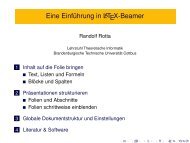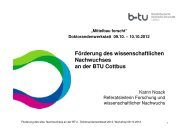Multilevel Graph Clustering with Density-Based Quality Measures
Multilevel Graph Clustering with Density-Based Quality Measures
Multilevel Graph Clustering with Density-Based Quality Measures
Create successful ePaper yourself
Turn your PDF publications into a flip-book with our unique Google optimized e-Paper software.
4 EvaluationThis chapter evaluates the family of algorithms developed in the previous chapter.The algorithms are composed of different components like coarsening method, mergeselector and so on. Specific algorithms are configured using a set of parameters.The key aspects of the evaluation are effectiveness, reliability, simplicity, andefficiency. An algorithm is effective when it finds better clusterings in terms of themodularity measure compared to the alternatives. This is strongly related to thereliability, i.e. finding these clusterings systematically and not just sometimes byrandom chance. Simplicity and efficiency are concerned <strong>with</strong> the question whethercomplicated or expensive components of the algorithm significantly improve theresults. This includes the study of the scalability to check how the runtime ofcomponents develops <strong>with</strong> the graph size. Expensive components <strong>with</strong> just small orno improvements could be omitted to simplify future implementations. At the sametime it might be possible to gain similar improvements <strong>with</strong> less effort using otherheuristics.Not all of these aspects can be treated in full depth in the scope of this work.Instead the evaluation mostly concentrates on the effectiveness compared to otherconfigurations and reference algorithms.The chapter is organized as follows. The next section summarized the configurationspace and introduces the main evaluation methods used in this work. The nextthree section study the effectiveness of the graph coarsening, the merge selectors andthe refinement. Efficiency aspects are also discussed where appropriate. The fourthsection discusses experimental results on the scalability of the algorithms. And thelast two sections compare the presented multi-level refinement method against otherclustering algorithms and results collected from the literature.4.1 Methods and DataThis section centrally discusses various aspects of the employed evaluation methods.The first subsection summarizes the algorithm components and describes the configurationspace spanned by the parameters. The second subsection introduces themean modularity method used to study the effectiveness of clustering algorithms.In this context also the collection of benchmark graphs is presented. Finally thelast subsection contains some notes on the evaluation of computation times andscalability.4.1.1 Configuration SpaceThe multi-level algorithm is configured by the parameters listed in the Table 4.1.This includes for example the coarsening and refinement methods and configuration59






